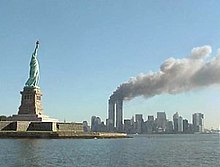A PTSD Society: A Society Post 9/11

National Park Service (n.d.). Statue of Liberty and World Trade Centers 9/11. Licensed under the National Park Service website under 9.11.01 Remembrance.
9/11 a day that will live in infamy as every person around the world can remember where they were and what they were doing when they saw this horrific terrorist attack take place. But since that day many other terrorist attacks have taken place on our soil, more than any that we have ever had in the history of our nation. Due to these terrorist and lone wolf attacks, I believe that many people in our society suffer from a minor form of Post Traumatic Stress Disorder (PTSD).
Now, this is not to be compared to the degree that we see many who have served in our military, those who were in the midst of attacks, or have suffered other traumas as being equal to the rest of society. But think about the anxiety many people now have when they travel, either by public transportation plane or train/subways, go to public markets, or city holiday events. At all these areas you now see security at every corner (or sometimes wishing you saw more of them), ready to take a stand against any unforeseen or seen threat that could take place at any moment. The stress, the anxiety, the noise, and your thoughts running a thousand miles per hour as you take your daily steps towards the subway, platform 2, that you have done every day for the past 20 years. But at the end of each day, you are glad you made it home, taking a deep breath, and thankful that nothing happened today or nothing happened in your area.
This type of PTSD according to the DSM-5 would be categorized as PTSD contracted by learning about or watching a traumatic event such as 9/11 and the other terrorist attacks (American Psychiatric Association, 2013). Most American’s have seen the attacks happen either at the site of the attack or on the news either right after the attack and looking at the aftermath or sometimes during an event such as the Boston Marathon Bombing. According to some studies conducted by Galea and Schlenger (as written by Resnick, Galea, Kilpatrick, and Vlahov, 2004) a few weeks after 9/11 around “44%” of people that they surveys had symptoms of PTSD. Then around a few months to a year later, around 11% or more in the Manhattan area showed signs of PTSD (Resnick, et al., 2004). I believe that if we did a survey from the general society and asked them if they struggled with certain symptoms associated with PTSD after learning about, watching, or witnessing a terrorist attack that we would learn that a lot of people struggle with it, even for a short time.
The media does a phenomenal job of helping us relive each terrorist attack as they repeat the event over and over until a new attack happens. And as new threats continue to be posted, more and more people are anxious to go to places that have big crowds.
As a flight attendant, I talk to hundreds of people every day who are traveling for fun, work, or to see family and so many of them are anxious. Sometimes the fear and anxiety are palpable. Just this past week I went to London right after ISIS had put out a poster saying that they were going to attack the Christmas Markets. My crew and I were aware of the threat, talked about potential problems, and then how we were going to be aware of what was happening around us, but not let the threats of terrorism thwart our Christmas shopping plans. During the layover, I went to Winter Wonderland in Hyde Park, which is a beautiful Christmas Market, but those coming in had a very different demeanor than those coming out of the market. Those going in had to be searched, some got pat downs, while the majority of us had our bags searched. You could see that the police and military were jumpy, ready for something to happen, which made those of us entering on edge. Once you were in, I noticed that people were not drinking alcohol (well some might have been drinking too much) as they usually do and they were watching everyone. But looking at those leaving, they were laughing and having a great time knowing that nothing happened and they were able to have fun.
As I said, the anxiety and fear were palpable, as the media images of a terrorist attack by IED’s, knife attacks, and car attacks were running through everyone’s minds. People showed obvious signs of PTSD, and I believe struggle with it due to what is happening in our world today. We don’t let the terrorist’s win by not going to markets or doing what we want to do, but we sometimes do those things with our eyes closed and taking a deep breath in as we know where we are going could change our lives in an instance.
Thank you for taking the time to read my post.
Bonita
Resources:
American Psychiatric Association. (2013). Diagnostic and statistical manual of mental disorders: DSM-5 (5th ed.). Washington, DC: American Psychiatric Publishing. doi:https://dsm-psychiatryonline-org.ezproxy.bu.edu/doi/book/10.1176/appi.books.9780890425596
National Park Services. (n.d). 9.11.01 REMEMBRANCE. Retrieved December 11, 2017 from https://web.archive.org/web/20021019052836/http://www.nps.gov/remembrance/statue/index.html
Resnick, H. PhD., Galea, S. MD, DRPH, Kilpatrick, D. PhD., Vlahov, D. PhD. (2004). PTSD Research Quarterly: RESEARCH ON TRAUMA AND PTSD IN THE AFTERMATH OF 9/11. Retrieved December 10, 2017 from https://www.ptsd.va.gov/professional/newsletters/research-quarterly/V15N1.pdf